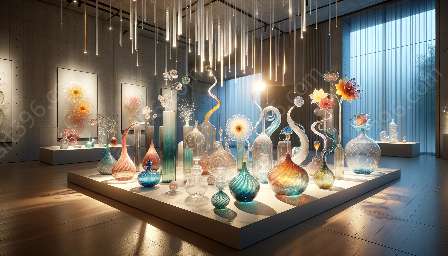Glass art intersects with the principles of human-centered design in interior spaces through its ability to enhance aesthetics, create unique focal points, and evoke emotional responses. When integrated thoughtfully, glass art adds a layer of depth and sophistication to interior designs, ultimately contributing to the overall human experience within a space.
The Influence of Glass Art in Interior Design
As an integral part of interior design, glass art influences the atmosphere, functionality, and visual appeal of a space. It offers a diverse range of applications, including decorative pieces, architectural elements, and functional installations, all of which contribute to the creation of impactful and inviting interiors.
The Role of Glass Art in Enhancing Aesthetics
One of the key intersections between glass art and human-centered design lies in their shared commitment to enhancing aesthetics. Glass art, with its inherent translucency, brilliance, and dynamic textures, introduces visual interest and beauty to interior spaces. Whether in the form of stained glass windows, custom chandeliers, or intricate glass sculptures, the artistic expressions of glass elevate the ambiance and provide a visually captivating experience for occupants.
Creating Unique Focal Points
Human-centered design prioritizes the creation of focal points that draw attention and engage the senses. In this context, glass art serves as a compelling medium for establishing focal points within a space. Its reflective properties and ability to manipulate light make it an ideal element to guide the eye and create captivating focal features that command attention and curiosity.
Eliciting Emotional Responses
Another area of intersection is the capacity of glass art to evoke emotional responses. Human-centered design aims to shape environments that resonate with individuals on an emotional level. Glass art, through its evocative forms, colors, and craftsmanship, has the power to evoke feelings of awe, tranquility, and wonder, ultimately enriching the human experience within interiors.
Functional Applications of Glass Art
Besides its aesthetic contributions, glass art also fulfills functional roles within interior design. From partitions and screens that offer visual separation while maintaining connectivity to custom glass installations that serve as elements of wayfinding and branding, the integration of glass art demonstrates its versatility and adaptability in addressing the practical needs of interior spaces. When applied with human-centered principles, these elements contribute to creating intuitive and harmonious environments.
The Collaboration of Glass Art and Human-Centered Design
In essence, the collaboration between glass art and human-centered design allows for the creation of interior spaces that harmoniously blend aesthetic allure with functionality, emotional resonance, and user-centric considerations. Through this synergy, spaces are transformed into holistic, immersive environments that cater to the diverse needs and experiences of occupants, offering a balance of visual delight and practical comfort.

